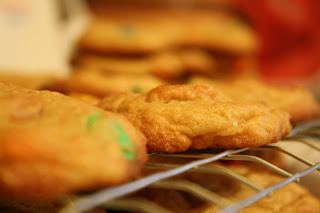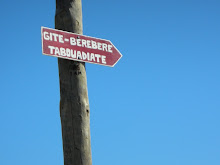Yesterday, Jon posted his
top ten memories of Morocco, and wanted me to do the same. I will say that we came up with our lists completely independently of each other and I haven't yet read what he's written, (which is killing me) and that's why I was so motivated to come up with my "top ten" as soon as possible. It was a little hard to narrow it down to ten, and most of my favorite memories happened over several days, weeks, or months. I've arranged my list in roughly chronological order.
Our first Eid KabirFor our first Eid Kabir we were still in home stay. We had seen pictures of Eid kabirs from other volunteers, so we had an idea of what to expect...the sheep slaughter in particular. The morning of Eid felt very much like any big holiday back in the States. We got dressed up and went over to Rachida's mother's house to visit and eat sweets then went back home to prepare for the festivities. The sheep was brought to the roof were we had the chance to look it in the eye for a few hours, knowing it's fate. Our host mom, Rachida, started the mijmare (small grill) that we'd use to cook the organ meat right after the slaughter. The mijmare is fueled by charcoal and is quite tricky to get going. As luck would have it it started to rain, so we moved indoors; grill, sheep and all. Since a woman isn't allowed to kill the sheep and our host brother was either still too young or inexperienced or both, a man came over to do the job. The sheep was killed over the bathroom toilet, so that it's blood would flow down the drain. We all gathered around the doorway to watch, but I started to feel sick to my stomach so I turned away after a while. After the sheep was skinned and the organs removed, our brother started grilling them over the mijmar in the living room, filling the house with smoke and causing our smoke detector to go off. My eyes became so irritated from the smoke that I had to stand by an open window. The organ meat was wrapped in fat, seasoned with salt, pepper, and cumin, and eaten with bread. It's was one of the most delicious meals I've ever had here!


Trip to Merzouga and the Todra Gorge with fellow PCVsThis was a trip that happened fairly early on in our service, in March 2009. It was our first time in the southern region of Morocco, so the landscape alone was something completely foreign to us. It was a pretty typical trip I guess you can say and we did the same things that many other volunteers have done. We rode camels in Merzouga to a Berber camp site were we spent the night and climbed at least part way up the big dune and looked at the stars. In Todra we hiked up to the top of the gorge where we were rewarded with a beautiful view (and Jon was rewarded with a shoe shine, but that's a different story). It was a great opportunity to see the parts of Morocco that I tend to enjoy more...the smaller towns and rural areas. They beat Marrakesh and Fes any day. There was a core group of four volunteers that went, with others meeting up and leaving along the way, but always great company.


Spring Camp 2009It was a crazy week of teaching English and art classes, playing unusual games, dancing, getting up early and going to bed WAY too late. Some highlights include;
One very intense game of ultimate Frisbee
Seeing one of the girls from my English class singing "The Hokie Pokie" to herself as she walked to lunch.
Singing "Bohemian Rhapsody" at the talent show with the other PCV counselors.
Learning circus tricks along with the kids
Attending one of the aerobics classes with all the teenage girls
Dressing up as a pirate for the costume party
Attending the awards ceremony the last night that lasted until 2 in the morning!
 Paper making project
Paper making projectThe paper making project has been an odyssey. From coming up with the idea, to constructing the mold and deckle, to gathering the materials, to teaching the women, to coming up with products to make out of it...it's been a long long process. To read more about the paper making project click
here and
here.

Learning to speak and write in a different language Learning Darija was one of the hardest things I've ever done and something I'm glad that I had the opportunity to do. By the time I reached my mid 20s I thought I'd never have the chance to learn a second language, but here I am. I give all the credit of any language success to final tutor, Salima, who started teaching me in June, 2009. She was patient, persistent, and a great teacher. She taught me how to write in
Arabic Script, and that really helped me with my pronunciation. Plus, it's really cool to be able to write things for my ladies and decipher signs. Though I feel self conscience about my language skills most of the time, it's nice when a complete stranger overhears me speaking to a shop keeper and strikes up a conversation with me because she can't believe how well I speak Arabic, which happened yesterday.

Day at the beach near AsilahOn a long holiday weekend during Ramadan in August 2009, Jon and I met up with several other volunteers, mostly from our staj, in Asilah, a coastal town in the north. On one of the days we took a trip to a place called Paradise Beach, just a few miles from town. We arrived early in the morning to find the most expansive, empty beach I've ever seen, and since it was the first or second day of Ramadan, it was practically empty. The tide was out and the sand was smooth and free of trash. We spent the day exploring the rocks, chasing seagulls, riding the waves on boogie boards, and lounging around under sun umbrellas reading.
 Ain LeuH
Ain LeuH This might be cheating, but I have three wonderful memories of Ain LeuH. The first was back in August, 2009 when we went there to participate in an Environment camp. The camp had many challenges but it was a great opportunity to meet with other volunteers and work with some really great kids. It was also when we first discovered Ain LeuH's treasure trove of blackberries and I made jam for the first time ever.

The Next time we went to Ain LeuH was for Christmas, 2009. It was pouring down rain on Christmas Eve as we made our way there from taxi to taxi. By the time we arrived we were soaked to the bone, but we were greatly rewarded. Randy's house (the volunteer who lives there) was warm, cozy and welcoming. Lisa and two of her friends from the US came as well and we spent the next two days making and eating delicious food, listening to Christmas music, and playing Scrabble. I made hand-knit Christmas gifts for everyone there and Santa even came and filled our stockings with treats. It was the most low-key, unstressfull Christmas I ever had, and although I missed my family back home, it was a wonderful experience. The picture below of Jon and Randy was taken the day after Christmas, as you can see, it ended up being a beautiful weekend.

Most recently we went back to Ain LeuH two more times in the last month for workshops and more
blackberry picking. The site is beautiful and there is nothing better than getting up at 6 o'clock to pick some berries before anyone is out and the sun gets hot.
Marché MarocThis again is a bit of a cheating response because there have been three Marché Maroc craft fairs, and I've enjoyed all of them. The best part of these craft fairs was seeing how much Fatima and Hefida grew and learned from their experiences attending them and how much fun they had each time. My work is a very important part of what I'm doing here (well, duh), but sometimes it's hard to pin point a specific time that was "memorable." It's the little things that happen on a daily basis that seem to add up, but the craft fairs gave me the chance to look back on my work here and see the bigger picture. For more on Marché Maroc,
check out this post.
 Learning Fesi embroidery
Learning Fesi embroideryFrom early on in my service, I have been particularly interested in a specific style of embroidery made here in Morocco called "Fesi" Embroidery. Shortly before our Mid Service Medicals in December, 2009, I decided to ask the women at the cooperative to teach me how to do it. I do a lot of mini workshops with the women to teach them different crochet techniques, so it was nice to change roles and be the student for a while. Since my work primarily consists of product development and quality control, it was very helpful for me to learn the "right" way to do this embroidery and better understand the labor that's involved. Since I'm about the same age as the coop members I think it was good for them to see that I'm not afraid to try new things and therefore it's never too late for them to learn something new. In fact, after I started doing my embroidery sampler one of the coop members who didn't do fesi embroidery decided that she wanted to learn too! It took about four months, but I finally completed the sampler. For more on Fesi embroidery check out
this and
this.

Teaching crochet in the bledThis past July I had the opportunity to travel down south and teach a crochet workshop in the bled (small community in the countryside, in this case about 500 people strong). The site doesn't even have transportation all the way to it, so we had to walk in from the nearest town, which takes about an hour. Though most of the area is dry and desert-like, the town is in the middle of an oasis. It was an extremely quiet place with all mud-brick houses. It's basically what a lot of people think of when they think "Morocco." The two sisters that I taught were very excited to learn the two-color crochet technique that I went there to teach. The workshop was supposed to last two days, and be about 2-3 hours a day. It ended up spanning four days with our average day being 8 or 9 hours! It was a really intense time and we all learned a lot. I really enjoyed how welcome the sisters and the rest of their family made me feel. It was very easy to joke around and talk with them. On my last day I even learned how to make cannon bread, which is a specific type of bread that I've only seen made in that area.
























































